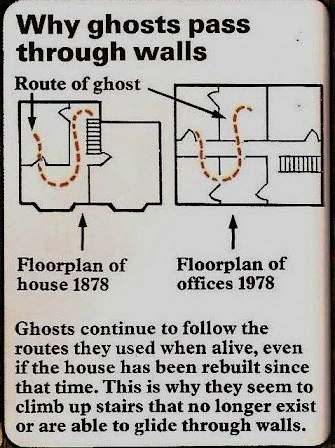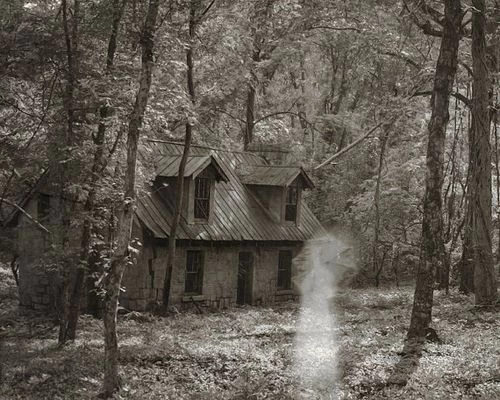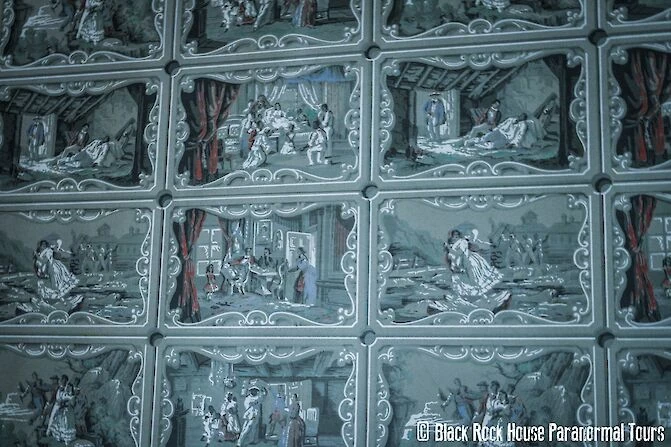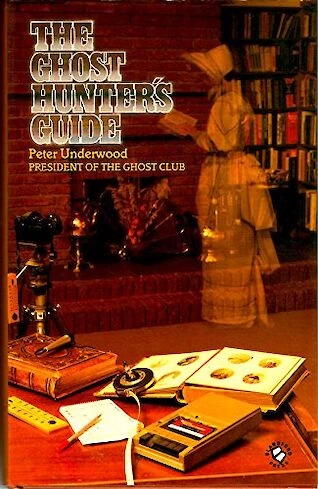

Types of Ghosts according to Peter Underwood
Famous paranormal researcher Peter Underwood is well known for his work within the paranormal field. As an author of over 50 books, president of the Ghost Club and member of the Society of Psychical Research, he had a lot to say when it came to paranormal phenomena. His involvement in the research of the Borely Rectory is probably what he is most well known for to those not as familiar with paranormal research.
In his book The Ghost Hunter's Guide published in 1986, Underwood details the different kinds of 'ghosts' he had put into different categories. These are the views according to Peter Underwood and do not necessarily reflect my own.
Atmospheric Photograph Ghosts
There is most certainly considerable evidence, from all parts of the world over many, many years, to suggest that certain events, often but not always traif or violent events, occasionally imprint themselves in or on the atmosphere of the place where the event occured. Possibly climatic conditions at the time play a part in this strange recording, possibly the presence of a certain type of person is necessary, or it may be that such events remain as light-particles, imprinted and vibrating for many years, possibly for ever, to be sensed or seen or otherwise experienced by some individuals who happen to be in the right place at the right time. I have noticed that such ghost imprints are very rarely reported in a high wind; such manifestations might be classed Atmospheric Photograph Ghosts.
Remembering that this book was published in 1986, what Underwood is talking about here is what modern-day investigators refer to as The Stonetape Theory - where certain atmospheric conditions could trigger some sort of playback. It is thought that some sort of traumatic event is imprinted within its surroundings and that certain conditions can trigger this playback. What is interesting however is that while most people focus on the conditions themselves, Underwood states that maybe a certain type of person is required for this to occur. He believes that a person could have what he refers to as a Mental Imprint Manifestation where they are unconsciously feeding this spiritual energy with whatever it is that they need to appear.
To read more about the concept of the stonetape theory, check out my article: The Stonetape Theory
Historical or Traditional Ghosts
These are usually associated with old and historic houses where uninterrupted occupation of the premises for many years seems to help to perpetuate the ghostly figures that are recognised as the forms of real people who once lived there. Such ghostly forms walk or seem to glide through rooms and passages that would have been familiar to them in their lifetime. They appear to be solid, seemingly dressed in the clothes of their times, and they usually act more or less naturally, although when structural alterations have taken place they will appear to walk through walls and closed doors that were nor there during their lifetime; and if floors and ceilings have been altered the ghosts appear where they would have appeared before such alterations took place, so that sometimes, when flooring has been raised, for example, the ghost appears only from the ankles or knees upwards. In common with practically all spontaneous ghosts they never speak and rarely show any sign of being aware of the presence of a human being, although, once they have been identified, it is often found that they have suffered in some way during their early life. They seem to have a kinship with the Atmosphere Photograph or Mental Image Ghosts, but are 'place-centred' and confined to ancient properties, and apparently continue to appear for many, many years, perhaps forever. Often they come to be treated as part of the family and fixtures, for they never harm anyone.
The above seems to refer again to a residual type of haunting, but one where a spirit is attached to a place. You may have seen a photo that often circulates on social media which was originally published in World of the Unknown: Ghosts by Christopher Maynard.

This is a visual that explains pretty much what Underwood is talking about. This kind of spirit in Underwood's eyes, still sees things very much as they were when they lived there. Instead of being tied to a place by atmospheric conditions, it is thought they are bound to the place itself. People tend to refer to this as a residual type haunting, as again you are watching more of playback and the spirit is not even aware that you are there.
To read more about residual hauntings, check out my article: Residual VS Intelligent Haunting
Cyclic or Recurring Ghosts
These come into a separate category because they return (or are alleged to return) at regular intervals. By far the commonest cycle is twelve months and we will be looking in Chapter 13, entitled 'A Ghost Calendar', at the truly remarkable number of ghosts that are reported to return annually, almost as though they require twelve months to build up sufficient power to manifest once again.
I have seen this referred to before as a type of 'Anniversary' haunting, where a spirit is said to make an appearance on the same date of each year. What I like about Underwood's take on this theory is that he also looks at the human mind connection. He uses the example of the spirit of a monk who is spotted on the 30th of March each year. "If a person who is aware of this story and visits the location on this day, he says it is only too easy to see what we (unconsciously) want to see and to hear what we (unconsciously) want to hear."
Modern Ghosts
It is a common misconception that all ghosts are misty Grey Ladies or shadowy monks of long ago; there are many modern ghosts and ghosts of modern people and present-day occurrences. For years a ghost bus was seen in North Kensington and many accidents were reportedly caused by other road users swerving to avoid the racing bus, hours after regular buses had ceased to run, only to find the brightly lit bus had completely disappeared. After one fatal accident (some say there were several) the dangerous corner at the junction of St Mark's Road and Cambridge Gardens was structurally altered and thereafter the ghost bus was not seen again.
The above story reminds me of another famous more 'modern' haunted that I have written about previously The Ghosts of Flight 401. Just because a building is old doesn't mean it is haunted and if it is correct that ghosts are the spirits or energy of a person who has passed away, then of course a ghost can be someone from not so long ago. As paranormal investigators, however, you need to remember that anyone who has passed has a family and especially if circumstances are traumatic, it doesn't automatically give you the license to start trying to make contact (especially on a public platform like YouTube). Often high profile deaths are exploited online by paranormal investigators and this is not ethical.
If you want to read more about the Ghosts of Flight 401, check out my article: The Ghosts of Flight 401
Ghosts of the Living
Prince Rupert led his cavalry into the first major battle of the English Civil War at Edgehill in 1642. For months afterwards people claimed to see a ghostly re-enactment of the battle, and among those reported to take part was Prince Rupert himself but he was still alive at the time. There are thousands of such instances; people passing a friend in the street and later discovering that at the time that person was undoubtedly elsewhere; people waking suddenly and seeing the unmistakable form of someone they know only to learn that that person was at the time miles away. Under this heading we must also consider the experimentally induced apparition, the ghost not of a dead or dying person but of someone alive and well who has deliberately made his or her image visible to someone else. G.N.M Tyrrell (President of the Society for Psychical Research 1945-6) relates sixteen successful attempts of this type in admirable study Apparitions (1943 revised 1953). This apparently repeatable experiment has been almost ignored by successive researchers and although there has been recent study in the realm of 'out-of-the-body' experiments good evidence of self-induced visibility at a distance is rare.
I have written before about Tulpas which are an extension of what Underwood is referring to above. It is derived from Tibetan Buddism where a being or object is consciously created using the power of one's mind.
To read more about Tulpas, check out my article: Tulpa, Poltergeists and Thoughtforms
Crisis Apparitions or Deathbed Visions
These post-mortem appearances take place at or soon after the death or near-death of the person seen and do not seem to be related to any particular place or event. They are quite common but are ghosts of limited duration and rarely occur more than four days after the death or crisis in illness of the person seen. A typical example would be of a man in England who had a daughter living in Australia. At any time of the day or night the daughter would be aware usually see the form of her father standing quietly looking at her, and subsequently, it would be established either that he died or reached a crisis of an illness at the time his figure-or ghost-was seen, or shortly before or after. Such single appearances were common during both the World Wars when wives and mothers 'saw' their husbands and sons, only to learn later that they had been killed at the time they had appeared to their loved ones.

The term apparition is quite a broad one. While many think it to just be a transparent 'ghost', there is a bit more to it than that. While some sightings could easily be dismissed by people, a crisis apparition is a little more credible in the eyes of a lot of researchers given the strange circumstances that surround it. The fact that they are seeing the 'spirit' of someone who they see sometimes before they pass, is quite intriguing.
To read more about types of apparitions and crisis apparitions, check out my article: Apparitions
Family Ghosts
These are ghosts which are attached to certain families; often their purpose seems to be to warn members of the family of approaching death. In general they seem to be more common in Scotland than elsewhere, while the Banshee (a wailing sound that heralds a family death) is exclusive to those descended from the ancient Irish.

While I often hear of a person being haunted rather than a location, the Banshee is something that seems to be rooted into folklore. There is a famous tale which I wrote about which occurred in 1770 which talks of a Reverend who became ill with reports of a Banshee calling out for him a week before his death. Check out my article: Reverend Charles Bunworth and the Banshee
Haunted Objects
Just as some houses seem capable of attracting and holding a ghost or ghostly happening, so too, but more rarely, do some objects seem capable of attracting and retaining a ghostly influence. Some objects, it has been noticed, are especially like to become Haunted Objects: many skulls are said to possess uncanny powers, and one immediately thinks of the skulls at Chilton Cantelo, Wardley Hall, Appley Bridhe, Burton Agnes Hall, Warbleton Oriory, Bettiscombe Manor and many others. The skull at Bettiscombe which Michael Finney showed me in the company of Lord Gibson, resided in a shoe box and was almost certainly the skull of a prehistoric girl who died some three or four thousand years ago. Michael Pinney told me 'It is said to scream and cause agricultural disaster if taken out of the house, and also to cause the death within a year, of the person who commits the deed. A photographer once carried it as far as the open doorway to take pictures of it, but my wife snatched it back indoors again without anything untoward occuring'.
Haunted objects are quite popular, especially today. All you have to do is look up 'haunted doll' on eBay and you are offered a range of items at very high prices and elaborate stories. Are they really haunted though? When you talk about items retaining energy imprints such as the Stonetape theory we discussed above, then you could say it is possible for a regular item to retain energy. If a child had a doll for example that they focused a lot of time and love into, would they leave a part of that energy behind? Psychic mediums can sometimes use an ability called psychometry where they are able to read the psychic imprint left behind. A haunted object however is where it is believed a ghost or spirit is attached to the item. Much like above where Underwood claimed a spirit was bound to a location, in this case, he is saying they are bound to the object. Maybe in some cases, people are confusing a psychic imprint that can be read by psychometry with it actually being haunted. It is also important to note there is A LOT of fraud within the Haunted objects field.
To read more about psychometry check out my article: Psychometry
Fraudulent Hauntings
Sooner or later every ghost hunter encounters the fraudulent in his search for the genuine ghost or haunting. Most frequently it will be found that what has been taken to be ghost has a perfectly rational and normal explanation. Such mundane things as loose water pipers, an air lock, and ill-fitting floorboards should always be examined, and also cracks in the walls, badly-fitting doors and a dip in the roof which suggest that the house may be moving on its foundations, causing all sorts of noises and 'strange' happenings such as 'mysterious' openings and closings of doors. Nearby water is always suspect, as a high water level in a river caused by abnormal rainfall can invade old and leaking sewers causing the ground beneath to a house to become waterlogged and unstable, which can again cause noises and happenings that can easily be regarded as 'inexplicable'.
A lot of the work I do as a paranormal researcher I guess is exploring a lot of the above. When Underwood refers to fraud, he isn't talking about people that are obviously faking things. While this does happen, a bigger problem is actually misinterpretation. A lot of what we experience is probably not paranormal, we just don't know the explanation for it. There is a term that is referred to as Xenonormal. To a person who is experiencing a type of phenomenon, it is paranormal to them because they do not have the knowledge to be able to explain it. To another person with experience in that area, it is simply something normal. A lot of the above mentioned by Underwood is learned experience that people tend to gain while out investigating the paranormal. That is why it is important that we share our findings with one another and we are willing to listen to what others have to tell us. For example, I would never have known that when it gets windy, the Wallpaper at Black Rock House a location I attend regularly makes crackly noises and actually moves. It makes it feel like someone is standing behind you. I wouldn't know this without being there to witness and see it myself. I then tell other people about this so if they are in a similar situation, they know that the noise they are hearing is most likely not paranormal and they know what to look for. Once you can discount these 'regular' explanations, what you are left with can be just as intriguing.

I write a lot about some of the natural things that can be mistaken as paranormal. Here is one of my articles in this area: Paranormal VS Nature
Survival After Death
This could be the most logical answer to a number of ghostly appearances; indeed in some instances it seems to be the only explanation possible. Survival of some part of the intelligence of some people seems likely in view of the available evidence, especially for a limited period; and this survival, be it temporary of permanent, would of course explain some of the well-attested instances of evidence of life after death that is to be found by the true searcher after truth among the records of spirutualism and its adherents. As far as ghost hunting is concerned, the ghosts that suggest survival after death are best investigated with the co-operation of committed but open-minded spiritualists who are aware of the many pitfalls that await the unwary in seeking proof of life after death and do not unquestionably accept any evidence that may be forthcoming.
Probably one of the most popular theories among the general population is that a ghost is the energy or spirit of a person who was once living. In more academic circles, it is referred to as 'survival after death'. A lot of paranormal investigators base their research and investigations on this very theory. It is why they will research the history of a location and the people who lived there. When they investigate, they try to ask questions relevant to this history or when reviewing evidence they collect, they try to match it back to historical records. A lot of this is in an effort to prove that this survival after death exists. Ghost hunting itself has become an evolved take on spiritualism - a practice where communication with spirits was seemingly demonstrated often through seance or psychic mediums.
To read more about spiritualism check out my article: Spiritualism
Other Explanations
Other possible explanations for some ghosts and haunting phenomena include Time-Slips where, for a second or a moment or longer, a past scene is replayed in the present time; Psychic Echoes where the sound of some past event recurs without any visual aspect; and Animal Ghosts which, if we are of the opinion that ghosts of human beings are spirit forms or in any way reflect a life after death, must force us into taking a totally different look at some apparitions. There is good evidence for ghostly horses and dogs, stories of which are especially common in the United States, Europe and many parts of Africa as well as Britain, but there are also, it seems, ghost cats, cattle, she and wild creatures too - birds, squirrels, bears, deer - the list is endless.
The concept of time slips is one that really fascinates me. I know I have ad many moments myself where I have wondered if what we experience is a slip in time rather than a ghost.
Animal spirits are another intriguing area. I wrote recently about Ghost Cats and their significance as most 'haunted' locations seem to have stories about Ghost Cats. To read more about this topic, check out my article Ghost Cats
There is quite a lot to absorb from the above. What we can see from here is that a lot of what we talk about when it comes to the paranormal is quite in line with what Underwood writes above. While you may not agree with everything he writings, exploring his writing is designed to make us think, discuss and maybe even inspire us to look at an area from a different perspective. Underwood also refers to the term Ghost Hunter quite a lot and that is something I wanted to quickly address. In today's world, a lot within the paranormal field get offended by the term of Ghost Hunter because they believe it has a negative image attached to it. They believe it doesn't properly represent what they do. In general many seem to believe a ghost hunter goes into a location 'hunting' for ghosts - a literal interpretation of the phrase you could say. They prefer to be called a paranormal researcher or investigator. They feel this term doesn't limit their research to just 'hunting for ghosts'. As you can see, Underwood never applied that thinking to the term. I think a lot of it comes more from social media and even paranormal reality shows. The point is, it doesn't matter what you call yourself, it is how you conduct yourself and research. I think we can all agree there is not just one explanation for a ghost. Let's start sharing our ideas and research because you just never know what you may learn!
What do you think about the above list? Do you agree with Underwood? Do you have your own theories? Do you have an experience with one of the above you wish to share? Tell me in the comments below!

All quotes are taken from The Ghost Hunter's Guide by Peter Underwood 1986
If you enjoy LLIFS, consider buying me a book (otherwise known as buy me a coffee but I don't drink coffee and I LOVE books). Your donation helps to fund the LLIFS website so everyone can continue to access great paranormal content and resources for FREE!

Top pages with similar subjects
Don't forget to follow the Facebook page for regular updates
Join the mailing list to receive weekly updates of NEW articles. Never miss an article again!
Buy the latest and past issues Haunted Magazine
Check out the books written by LLIFS
Comments
-
Carol Hyman 2 years ago
Would love these articles.
-
Natalie Vujovich 3 years ago
Great article and interesting to look at the different types of "hauntings" that may be out there. I am a big believer in the "time slips" theory - are we seeing a true ghost or is it actually us from a different time line?